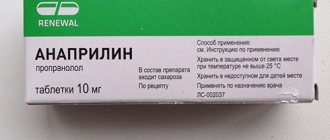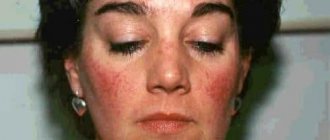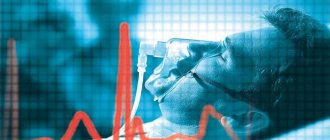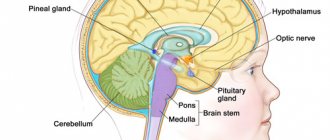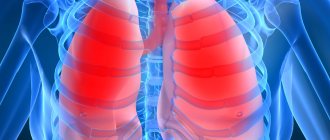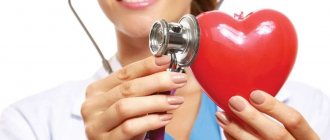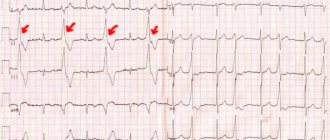What is it and what functions does it perform?
Cholesterol, cholesterol is an organic component, a natural fat-soluble compound that is part of the cell wall.
Types of cholesterol:
- Low-density lipoprotein (LDL) is “bad.”
- High-density lipoprotein (HDL) is “good.”
Its main task is to transport substances into the cell and back.
It takes part in the production of female hormones , in the metabolism of fat-soluble vitamins, in the production of vitamin D, protects cell membranes, insulates nerve fibers, and is an additional element in the formation of bile products.
30% of cholesterol comes from food, and the rest is produced by the body itself.
Cholesterol analysis - important numbers in this video:
The role of cholesterol and its norm in the blood
It is absolutely wrong to say that fatty compounds pose an unambiguous danger. This is not true at all. Moreover, they play a construction role; without them, life itself and the existence of the organism are impossible.
To be more specific, the basic functions of cholesterol are as follows:
- Ensuring normal cell wall formation. The substance makes the membrane strong enough and gives the structures the necessary physical properties and mechanical characteristics.
- Synthesis of sex hormones and some other substances. Without fats, structuring is impossible. As well as the normal functional activity of the named compounds.
- Synthesis of vitamin D. Without which, again, the body’s functioning is impossible in principle.
Cholesterol acts as the basic material for creating body tissues. Therefore, there is no need to talk about any harm if the concentration of this compound is at a normal level.
Reference values are determined by laboratories. It all depends on the characteristics of the assessment method used. Typically, a normal total cholesterol level is considered to be 5.2 mmol/L. However, it is necessary to conduct specific research based on gender, age and health status.
Interpretation requires individual work. In some cases, cholesterol levels may increase as a result of the influence of natural factors: physical activity or other factors.
High level reasons
The main reasons why cholesterol may increase:
- smoking;
- insufficient physical activity, sedentary lifestyle;
- pregnancy;
- frequent consumption of alcoholic beverages;
- diabetes;
- hereditary predisposition;
- obesity;
- kidney diseases;
- hypertension;
- pancreatic diseases;
- chronic increase in blood pressure (hypertension);
- liver pathologies.
An important source of increased cholesterol is the onset of the menstrual pause. During this period, women's protective functions decrease.
This condition is considered the most favorable for increased cholesterol deposition in blood vessels. Often the symptoms of pathology go unnoticed.
The reason for this is the woman’s poor health , which is associated with the onset of menopause.
The same can happen during pregnancy. The expectant mother, due to changes in the body, accompanied by general malaise, may not notice the main problem with cholesterol deposition.
Since during pregnancy a woman's production of progesterone , the hormone responsible for fat deposition, increases, the doctor may recommend that the pregnant woman undergo blood tests several times to rule out an increase in cholesterol levels.
And what is the normal level of general indicator in the blood of women:
- at 20 years old - 3.16-5.6 mmol/l;
- at 30 years old - 3.36-5.95 mmol/l;
- at 40 years old - 3.81-6.52 mmol/l;
- at 50 years old - 4.0-7.3 mmol/l;
- at 60 years old - 4.2-7.5 mmol/l;
- at 70 years old - 4.48-7.42 mmol/l.
Read about what tests are done during menopause in our publication.
You can learn how to correctly determine your facial skin type from this article.
Recipes for masks for hair growth that are easy to make at home are in this material.
Causes of hypercholesterolemia in men
Despite the fact that cholesterol is very important for a man, its daily requirement is not so great. The body itself copes well with fully providing the required amount of lipid complex. With proper nutrition, intake from food does not play a noticeable role; in excess, it becomes a cause of health problems.
There are two main fractions of cholesterol: LDL (low-density lipoprotein - dangerous fats) and HDL (high-density lipoprotein - healthy fat). As long as they are balanced, everything is fine, but if HDL is redistributed in favor of LDL, atherosclerotic plaques appear on the walls of the arteries. Why? Because HDL has the ability to transport excess LDL back to the liver, reducing it is akin to disaster.
Plaques on the vascular endothelium block blood flow to organs and tissues, disrupt nutrition and oxygen supply to the brain, heart, and kidneys, causing the development of ischemia, hypoxia, resulting in a heart attack or stroke. At the same time, the reasons that can provoke an increase in cholesterol (especially bad cholesterol) in the blood of men can be different:
- abuse of polyunsaturated fats: margarine, full-fat dairy products, chicken with skin, fast food, all deep-fried foods;
- regular inclusion in the menu of transgenic fats, which are used to prepare all commercial sweets: muffins, croissants, cookies, biscuits, cakes (failure to stop in time creates a risk of developing diabetes mellitus plus atherosclerosis);
- love of canned food, offal and white bread;
- abdominal obesity after 35 is an indicator of a decrease in testosterone levels (if your waist circumference exceeds 100 cm, sound the alarm and urgently solve the problem, since a “labor callus” on the stomach is nothing more than a sign of impending erectile dysfunction, impotence);
- physical inactivity: dosed and regular physical activity increases HDL, that is, it saves you from hypercholesterolemia, their absence opens the way for uncontrolled growth of LDL (this is the risk of developing cardiovascular pathology, encephalopathy, liver diseases, stomach diseases, renal failure);
- bad habits provoke hypertension, which often leads to heart attacks or strokes, more often developing in men;
- dysfunction of the thyroid gland, pituitary gland, and adrenal glands is another cause of hormonal imbalance and high cholesterol;
- stress, which causes appetite and, as a result, hypercholesterolemia;
- age-related changes in metabolic vessels with the deposition of atherosclerotic plaques;
- uncontrolled use of medications, poor ecology affecting hormonal levels and metabolic processes are also the cause of increased cholesterol;
- hereditary predisposition.
In fact, the reasons that cause increased cholesterol give rise to two main mechanisms for the development of hypercholesterolemia in men. The first is metabolic disorders or hormonal dysfunction that regulates metabolic processes. The lack of energy for liver cells against this background causes the breakdown of fatty deposits, which stimulates the synthesis of cholesterol from free fatty acids.
The second is stress, which provokes the release of cortisol and adrenaline into the blood, they stimulate the breakdown of adipose tissue and trigger an increased formation of cholesterol in the body.
Who is at risk
Doctors believe that the pathology can be caused by a sedentary lifestyle, uncontrolled consumption of fatty and high-calorie foods, and overeating.
The source of high rates may be long-term use of hormonal contraceptives.
The age of the woman is also important in this case. Over time, cholesterol levels in the female half of humanity may change.
This process depends on the presence of diseases and pathologies. Uncontrolled consumption of alcoholic beverages, smoking, and junk food leads to exhaustion of the body.
As a result, metabolic disorders, various diseases and a sharp jump in cholesterol in the blood.
How is high cholesterol diagnosed?
Cholesterol levels in clinics are checked using a lipid profile (or lipid profile) - this is a comprehensive study that determines lipid levels. It also helps identify:
- triglyceride level;
- concentration of low or high density lipoproteins;
- level of apolipoproteins A1, B;
- cholesterol concentration in the blood.
Indications for a lipid profile are:
- pathologies of the heart and vascular system;
- kidney diseases;
- diseases of the liver and biliary tract;
- stomach and duodenum;
- diabetes mellitus type 1 and 2;
- obesity;
- pathologies of the thyroid gland;
- blood diseases;
- malignant neoplasms in the body.
If the results of the study reveal an excess of the norm, they talk about hypothyroidism, diabetes, kidney pathologies or a tumor in the pancreas.
In case of deviations from the norm to the lower side during the study, starvation or cachexia is diagnosed. Low levels also indicate bone marrow pathologies, iron deficiency anemia, blood poisoning or chronic diseases that occur unnoticed in the body and cause constant focal inflammation.
Symptoms
Increased cholesterol in women can be recognized by the following symptoms:
- severe headaches;
- dizziness;
- presence of blood clots;
- pain and heaviness in the legs at the slightest physical exertion;
- the appearance of yellowish spots on the skin and in the eye area (xanthoma);
- heart failure.
The increase in cholesterol itself is not accompanied by symptoms : they occur after the development of atherosclerosis - the main consequence of the pathology.
Therefore, you need to take blood tests for prevention at least once every 1-5 years.
Possible complications
Elevated levels of cholesterol in a woman’s blood for a long time can be quite dangerous and often cause the following pathologies :
- coronary heart disease, characterized by impaired blood supply to the myocardium;
- heart attack;
- angina pectoris, which occurs due to narrowing of the coronary arteries;
- stroke.
It is very important to eliminate the problem at the initial stage of its development by taking tests on time and consulting a doctor.
Therapeutic approach
Treatment for hypercholesterolemia varies depending on many factors. That is, its complexity and the means used during therapy will directly depend on concomitant diseases or the severity of the woman’s condition.
Therefore, before developing a strategy to lower blood cholesterol in a patient over 50 years of age, you should initially determine all the diseases she currently has. After all, some of them can significantly affect cholesterol levels.
For example, stagnation of bile is often accompanied by an increase in the concentration of total cholesterol, as well as its “bad” fraction. In diabetes mellitus, the content of atherogenic (low-density lipids) cholesterol increases. In addition, various medications used by the patient can also cause an increase in the indicator.
It is very important to take into account a woman’s weight when choosing therapy. In a situation where the body mass index exceeds 30 kg/m2, that is, so-called obesity is present, it itself can be the cause of high cholesterol.
If the patient’s fat deposits are mostly concentrated in the abdominal area, then we are talking about abdominal obesity. This type of obesity is called “male type” and is considered more serious, since it is often complicated by additional problems such as diabetes, arterial hypertension and metabolic dysfunctions.
Diet correction
Diet is especially important for high cholesterol. It is necessary to adhere to two fundamental rules: reduce the amount of animal products in your daily diet and add more plant-based ones. A strict diet is not required in this situation, and in many cases with minor corrections, substance levels return to normal.
To reduce blood cholesterol, you should avoid foods that include:
How to lower bad cholesterol in the blood?
- fatty types of meat and poultry;
- confectionery, sweets, baked goods, chocolate, baked goods;
- strong broths (meat and fish) and soups prepared on their basis;
- sauces and dressings with high fat content;
- offal of any type, eggs, caviar;
- fatty dairy products.
It is also not recommended to drink strong tea, coffee, sweet carbonated and cocoa drinks. It is forbidden to drink alcohol, and even beer. Avoid products with hydrogenated fats or so-called trans fats, as they reduce “good” cholesterol and increase “bad” cholesterol.
Also, with a cholesterol-lowering diet, drinking regime is important, so you need to drink about 2 liters of liquid per day. These can be weak teas, herbal decoctions, compotes, fruit drinks, juices, etc. You need to eat regularly and be sure to eat well.
In this case, preference should be given to a gentle mode of food processing: steaming or grilling, boiling, stewing, baking, minimizing frying using animal fats and oil. You need to introduce more vegetables and fruits into your diet.
Throughout the day, you must eat three main meals, which include breakfast, lunch and dinner, as well as 1-2 additional ones (second breakfast and afternoon snack). Of course, restrictions in the diet should be reasonable, since the same dairy products or eggs contain many useful proteins and microelements, so it is recommended to consume them, but in small quantities.
If you have high cholesterol, you should not eat fast food, fatty or fried foods.
In addition, even if a woman’s cholesterol level is normal, she definitely should not neglect the advice described above. Proper nutrition is a significant factor in lowering high cholesterol, but it is far from the only one.
To give up smoking
Heredity, physical activity, diet and smoking play a significant role in the development of CVD. And if a person is not able to influence his genetic predisposition, then it is quite easy to keep all other risks under control.
Reference! Quitting smoking reduces the risk of coronary heart disease, the main cause of heart attack, by half!
The first results are already observed after a month - a slight decrease in “bad” cholesterol and a noticeable increase in “good” cholesterol are determined. And getting rid of this bad habit for two years reduces the risks of non-fatal heart attack and coronary death by more than a third.
Physical activity
The effect of physical activity on the cardiovascular system has been proven for a long time and is regularly confirmed in practice. All doctors, without exception, are confident that in case of heart problems, physical activity of almost any kind significantly improves the health situation.
Large-scale studies conducted recently have shown that moderate, that is, non-intense physical exercise is most beneficial. Excessive exercise can aggravate the disease. In this case, the type and mode of training in each specific case is selected individually.
For people who do not suffer from cardiac complications, higher loads are also allowed. Walking, swimming, cycling, skiing and jogging are good for them. It is recommended to conduct such exercises at least three times a week, and their duration should be at least 45-50 minutes, combining warm-up time and a “cooling down” period.
Drug therapy
Correction of fat metabolism dysfunctions usually begins with the above measures, consisting of diet, feasible physical activity and smoking cessation. Lipid-lowering drugs are prescribed only in situations where these methods do not lead to the expected effect for three months.
Statins are currently considered the gold standard of drug therapy. Drugs in this group effectively reduce cholesterol concentrations and normalize blood lipid levels in almost 60% of cases. However, unfortunately, they, like most other medications, have contraindications, and negative side reactions may occur when taken.
For example, statins are prescribed with extreme caution to patients with acute liver diseases, fatty hepatosis, etc. To minimize such risks, it is recommended to start taking these medications with minimal doses, which are gradually increased.
How to be treated
Medications
An increased content of the cholesterol component in the blood will become a source of fatty deposits in the blood vessels.
These deposits will be the source of a decrease in blood flow dynamics, due to which the brain and heart cease to receive the required amount of oxygen-enriched blood for normal functioning.
Treatment of the disease is based on taking lipid-lowering drugs .
More often, a doctor for hypercholesterolemia (increased cholesterol levels in a woman’s blood) prescribes the following medications:
- Gemfibrozil (Lopid, Hypolixan, Normolil, Gevilon), Fenofibrate, Clofibrate. Available in the form of tablets and capsules. Prescribed 2 times a day, one capsule (tablet). The drug is contraindicated for pregnant women and people with gallbladder diseases.
- Vitamin B3, PP and niacin can reduce cholesterol levels. Take 2-6 grams. per day, dividing the dose into 3 doses. To prevent fatty liver degeneration, methionine is prescribed at the same time.
- High cholesterol can be treated with drugs belonging to the group of bile acid sequestrants. These are Cholestyramine, Questran, Cholestan. Medicines are available in powder form. They are usually prescribed in doses of 4 grams. 2 times a day.
- Medicines belonging to the statin group are also capable of reducing the production of lipoprotein: Fluvastatin, Simvastatin, Pravastatin, Rosuvastatin. Drugs are prescribed at 5-10 mg per day.
Statins can lead to the development of diabetes. Therefore, it is not recommended to self-prescribe medications that can lower cholesterol levels.
ethnoscience
Traditional methods of therapy can also reduce cholesterol levels.
Herbalists often recommend consuming periwinkle . Just half a teaspoon of the herb, poured into a glass of milk or water, will get rid of pathology.
Take the medicine once a day before meals. Hawthorn blossom can also reduce cholesterol levels. 2 tbsp. l. The dried plant is poured with a glass of boiling water.
The future medicine should infuse for 20 minutes. You should take it one tablespoon 3 times a day. Caucasian Dioscorea is good .
Grind the rhizome of the plant and mix in the same amount with honey. Take half a teaspoon 2 to 4 times a day.
The duration of therapy is 10 days. Walnut leaves are also effective against pathology.
Chop 5 leaves and pour 500 ml of boiling water. The decoction is infused for 1 hour. Take half a glass 3 times a day before meals.
How to lower blood cholesterol levels:
We'll tell you how to do a mustard wrap for weight loss. Find out more now!
How to choose a hairstyle according to a woman’s face shape? Useful recommendations are in our article.
Reviews of keratin eyelash lamination are presented in this publication.
Drug cholesterol lowering
Modifying dietary habits is not enough to normalize high cholesterol levels, because it depends not only on what we eat: it is largely produced by the liver.
If its levels are very high or there is a serious cardiovascular risk, doctors recommend taking medications that lower high cholesterol for life.
How to treat the disorder? Most often, statins are prescribed, which block the synthesis of a substance in the liver. True, they have a fairly solid list of contraindications. Drugs in this group (Crestor, Lipitor, Mevacor), as well as medications with nicotinic acid (Niacin), help balance the level of good and bad cholesterol.
If side effects occur, Transverol is prescribed. Bile acid sequestrants prevent the absorption of dangerous substances in the intestines: Questran, Colestipol. If tests reveal elevated cholesterol, the choice of medications and treatment regimen should only be made by a doctor. He will also recommend vitamins: B3, B6, B12, E, folic acid.
What not to do when promoted
To reduce high blood cholesterol levels in women, you need to avoid the following foods :
- salo;
- lamb, pork;
- yolks;
- offal;
- beef, veal;
- margarine;
- coffee;
- canned food;
- mayonnaise;
- duck meat;
- sausages, sausages;
- easily digestible carbohydrates (sweets, pastries, cakes);
- fast food;
- fermented milk and high-fat dairy products.
Fatty, fried, hot and spicy foods should be excluded from the diet
Doctors also recommend giving up bad habits - limiting or completely giving up alcohol, quit smoking, and avoid stress.
Diagnosis of the problem
The main way to diagnose high cholesterol is a blood test. It is included in the clinical minimum examination of each patient who seeks medical help in the clinical examination program. For the study, 5 ml of blood is taken from a vein on an empty stomach. Decoding the analysis is the prerogative of the doctor.
For men it is determined:
- OAC and OAM to clarify the patient’s general health status;
- biochemical analysis with determination of blood sugar, creatinine, uric acid levels - metabolic markers;
- total cholesterol (TC) – the sum of all fractions;
- LDL – low-density lipoproteins (if necessary – VLDL: very low-density lipoproteins);
- HDL – high-density lipoproteins (if necessary – DILP: intermediate-density lipoproteins).
An extended version of the examination may be prescribed with blood tests for triglycerides, immunological, genetic testing, and a lipid profile to exclude the family nature of the pathology and clarify the type of hypercholesterolemia.
Lipid levels change over the years, which is taken into account when deciphering the data. The norm of cholesterol in the body of a 20-year-old man (from 3 to 5 units) differs significantly from the norm of a forty-year-old patient (from 3.5 to 7), especially from the cholesterol of elderly people, who show a maximum at 50-55 years of age (up to 7.2 mmol /l).
The ratio between LDL and HDL is approximately 50:50.
How to eat: creating a diet menu
To support the production of “good” cholesterol and counter the formation of “bad” cholesterol, you should consume foods containing fiber, monounsaturated fatty acids, polyunsaturated fats (Omega-3, Omega-6, Omega-9) and pectin.
“Good” cholesterol is found in fatty fish - mackerel, tuna. By eating 100 grams of boiled fish 2 times a week , you can reduce the risk of blood clots and keep your blood in a thin state.
It is better to season salads with olive, sesame or flaxseed oil. Eating olives will be beneficial.
Before purchasing, you need to pay attention to the inscription. The packaging must indicate that the product does not contain genetically modified substances .
Some of the most recommended foods for high cholesterol in women are pistachios, almonds, cashews, sunflower seeds, pine and Brazil nuts .
This is a very fatty food, which is mostly polyunsaturated, that is, very healthy. You should consume 30 grams of nuts per day.
Fiber is very useful in this case. This component is found in vegetables, seeds, bran, whole grains, fruits, legumes, and herbs.
By consuming 2-3 teaspoons of bran daily (with a glass of water), you can quickly reduce cholesterol levels in the blood.
Products containing pectin remove excess cholesterol from blood vessels. A lot of the substance is contained in apples, seeds, citrus fruits, and beets.
Green tea can balance the levels of “bad” and “good” cholesterol. Mineral water has the same properties.
Among the drinks you can highlight juices: orange, pineapple, apple, grapefruit, beetroot and carrot . You should start by taking one teaspoon per day.
You should consume fermented milk products with a low fat content .
Food processing is important: in case of pathology, you need to steam the food .
What can cause cholesterol to rise?
In 80% of cases, the accumulation of excess cholesterol is caused by poor diet and lifestyle.
- Abuse of alcohol, smoking. Ethyl alcohol and nicotine disrupt lipid metabolism, causing increased production of LDL by the liver. It turns out that good HDL simply does not have time to protect the blood vessels. Nicotine resins and alcohol, by themselves, without connection with cholesterol, make blood vessels brittle, permeable, impair liver function, which increases the risk of atherosclerosis.
- High blood pressure. Chronic hypertension often causes damage to the vascular walls. This can lead to the accumulation of fats, from which atherosclerotic plaques subsequently form. Lipid imbalances can also cause hypertension. Constricted blood vessels increase the load on the heart, forcing it to work harder.
- Poor nutrition. The predominance of fatty foods, semi-finished products, spicy, pickled, smoked foods disrupts lipid metabolism. Fats do not have time to be processed and are stored “in reserve.” If you become overweight, cholesterol levels increase. The risk group also includes lovers of low-fat, cholesterol-free diets. Not receiving the necessary fats from the outside, the liver begins to produce more of them than necessary to replenish the missing elements.
- Unstable psycho-emotional state. During stress, cortisol is produced, which breaks down a protein that increases blood glucose levels. All this disrupts metabolism and leads to vascular inflammation.
- Chronic diseases: dysfunction of the liver, kidneys, thyroid gland, diabetes mellitus. All diseases cause lipid imbalance and inflammation of the vascular walls. With high cholesterol, the risk of atherosclerotic plaques increases.
- Medications: diuretics, steroids, oral contraceptives, beta blockers. Increased concentrations of harmful LDL are sometimes a consequence of taking these drugs. No specific treatment is required. Lipid levels return to normal 3-4 weeks after stopping medication.
In 20% of cases, hypercholesterolemia appears due to genetic abnormalities. The liver produces excessive amounts of this substance or does not remove LDL from the blood. Signs of hereditary hypercholesterolemia usually appear after 18-20 years of age.
In women, cholesterol increases during menopause, when estrogen production stops. It is this hormone that prevents an imbalance in lipoprotein levels before menopause. However, if the body is healthy, the metabolism will normalize as soon as the hormonal levels stabilize.
Men initially contain very little estrogen. Therefore, their risk of atherosclerosis and cardiovascular diseases is higher. Men are advised to control their cholesterol levels starting at age 30, when the activity of metabolic processes decreases.

